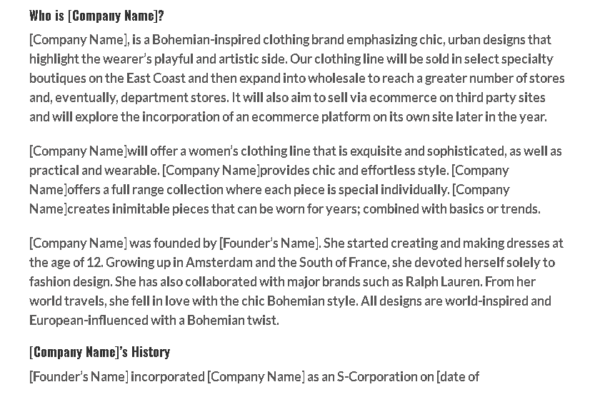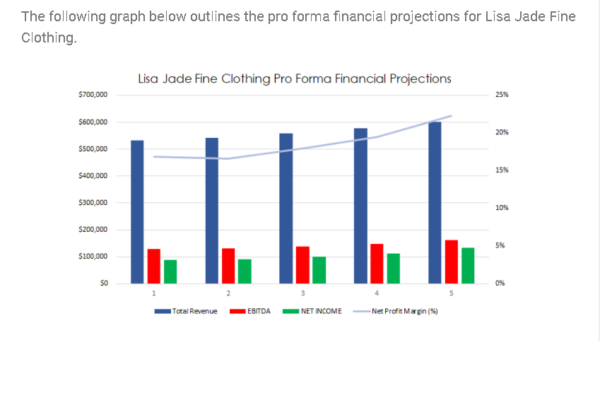
Like any business endeavor, successfully starting a clothing line takes preparation, time, and commitment. Before you start a new business, you’ll need to consider the price of supplies, rent, utilities, and the labor required to keep things running smoothly. Your fashion brand will also want to consider marketing strategies, profit projections, and long-term objectives. This is where having a solid clothing line business plan comes into play.
A business plan is a road map that thoroughly outlines your venture’s vision and scope. One of the main reasons why new companies need a business plan is to demonstrate profitability to lenders like banks or private investors. Before offering financial backing, potential investors will carefully review your business plan to examine all the risks involved, the growth potential of your clothing line, and many other considerations.
In addition to piquing investor interest, having a clothing line business plan will provide a solid foundation for how your company will operate moving forward, including its management structure, annual budget, product line, and more.
Breaking into the fashion industry can be challenging without a comprehensive business plan. If you’re wondering how to make a plan for a fashion brand and don’t know where to start, this guide will help put things into perspective.
Get all the tools you need to quickly find new customers and grow your retail store’s sales.
Benefits of having a fashion brand business plan
By putting all aspects of your fashion brand on paper first, you’ll encounter fewer surprises as you work to make a name for yourself and your company. Here are just a few of the many advantages of writing a business plan for your clothing line.
Helps to define your company’s core values and goals
Making a business plan can help you create consistent messaging regarding your clothing line’s primary objectives and fundamental values. Defining what your company stands for helps attract investors and also helps generate greater interest from top-tier managerial talent seeking a business model they can believe in.
As your business plan starts to come together, you’ll begin to recognize the unique aspects of your clothing line that set your company apart from the competition. The defining characteristics of your clothing line that arise from drafting a well-structured business plan will help you cultivate a unique brand that employees and customers are excited to support.
Removes the guesswork from the equation
One key benefit of creating a business plan is that it addresses many of the unknown variables and contingencies that might otherwise be overlooked. A good business plan should work much like a simulation on paper, accounting for factors like inventory breakage, revenue projections, overhead expenses, and equipment costs.
There’s nothing worse than realizing the working capital you’ve acquired to start your clothing brand isn’t enough to hit the ground running or that your labor costs are much higher than you initially thought. Compiling everything into a structured format lets you move forward with confidence knowing you’ve accounted for every aspect of your business.
Makes your clothing line more appealing to investors
Whether you’re seeking financial backing from angel investors or a local bank, having a solid business plan can make all the difference. Individuals or lending institutions are far more likely to support your fashion brand if they’re confident in your products, leadership, and objectives.
In short, a concise business plan can assist in expanding your network of possible funding sources for your startup clothing line and may even help you qualify for more cash upfront. Without a solid business plan to evaluate, many potential investors will move on to a company that knows exactly what it wants to accomplish and how it intends to do so.
Establishes clear benchmarks for success
A fashion brand business plan will help define your company’s near-term, mid-term, and long-term goals. Putting these objectives in writing provides a clear direction for your clothing line over the years ahead, instilling focus in yourself and your employees. These goals may include acquiring a certain number of email subscribers or simply hitting a revenue threshold within the first few years of opening.
Outlining your objectives in a business plan gives your clothing line a persistent target to pursue, and this clarity of purpose will quickly become a defining feature of your brand. As your clothing line meets and surpasses the goals you’ve established in the business plan, you can feel more confident about expanding or taking things in a new direction.
Outlines your clothing line’s financial outlook
Probably the most substantial benefit to making a business plan is that it provides you with the opportunity to carefully review the financial side of things before opening your business. Estimating cash flow, net profit, and monthly expenses can eliminate many future accounting problems and help investors determine the profitability of your company.
In the process of estimating income versus fixed costs, you may discover bills, taxes, and hidden expenses that you never considered before. Knowing exactly what to expect financially when you create a fashion brand can drastically reduce the chances of your clothing line running into liquidity issues later on.
The 4 key parts of a business plan
Most business plans are structured very similarly to one another, regardless of industry. At first, writing a plan can seem daunting due to the many sections and subsections it contains, but the backbone of your presentation should focus on a few fundamentals. Here are the four main components of a business plan that every entrepreneur should know.
Executive summary
The main focus of any clothing line business plan is the executive summary. This part provides a brief overview of all the information contained in the rest of your plan, making it easy for investors to quickly ascertain the basics of your fashion brand at a glance. Ideally, executive summaries should be concise, easy to read, and limited to a single page.
Some information to touch upon in this section includes a brief glimpse into your clothing line’s financials, a description of your product line, and projections for future growth. This is also an excellent place to briefly mention marketing strategies. In addition, you may want to include a short statement discussing your fashion brand’s market opportunity and how your business intends to maintain a competitive edge.
Management structure
Knowing who’s behind the scenes at your clothing line can also make a big difference in the overall appeal of your business plan. This section should discuss the pivotal leaders in your fashion brand, their relevant industry experience, and how they’ll contribute to the overall success of the company.
If you plan on sharing ownership of the business with others, you’ll also want to include how much stake they have in the company and how ownership would be divided if a partner ever leaves. Be sure to include the names and experience of any consultants you work with, such as a dedicated accountant, attorney, financial advisor, or part-time CFO.
Marketing strategy
The marketing section of your fashion brand business plan should dive into the specifics of how you plan to engage your target audience, eventually converting them into loyal customers. Discuss how you’ll use social media marketing, pay-per-click advertisements, and email to generate traffic to your website or physical store. And don’t forget to provide an annual cost estimate for financing your outreach strategies.
Other essential data to convey here should include trends in the clothing line market and how your company will seek to compete with other businesses in the industry. Be sure to mention any defining characteristics of your products and services that set you apart in the field, such as offering free shipping to new customers or providing discounts to email subscribers.
Financial summary
Another essential part of any business plan is the financial outlook section where you dig into the details of your clothing line’s expected revenue and expenses. Other information to cover here should include your fashion brand’s current working capital and how much funding you may need for equipment, personnel, fabrics, and other startup essentials.
You’ll also want to include a balance sheet depicting your projected financial situation, taking into account all sources of revenue and estimated expenses. If needed, it may help to enlist the guidance of an accountant or other financial expert to ensure all the information in your summary is as accurate as possible.
10 steps to creating a clothing line business plan
Now that you understand the basics of crafting a fashion brand business plan, you’re ready to begin bringing everything together into a cohesive format. Luckily, this process is fairly straightforward. Follow these 10 simple steps to write a plan that encapsulates your vision for the company.
1. Review business plan templates and examples for inspiration
Start generating ideas by exploring examples of completed business plans or browse among the many free business plan templates available online. Consider details like color schemes and fonts to make your presentation stand out from the crowd. You should also pay careful attention to the arrangement of each section.
For instance, it’s usually best to list your financial information toward the end of the document to encourage investors and banks to review the entire document before making a decision. You will also want to ensure your business plan has a well-organized table of contents so readers can easily navigate from one section to another.
2. Write an executive summary
As previously mentioned, the executive summary is potentially the most important section of any business plan. If you’re having trouble with this part, work on writing a short paragraph summarizing the history of your fashion brand and where you expect to see the company in three to five years. From there, you can extract the main takeaways from each of your plan’s additional sections and save the finer details for later.
3. Include company information
This portion should introduce your clothing line to readers, touching upon the values and goals that make your brand unique. Sub-topics may include a detailed timeline of your company’s story, who owns the business, and whether your fashion brand will operate primarily online or from a brick-and-mortar location. If you’re seeking financial support to open a new location, discuss how the expansion could facilitate increased sales and faster growth.

4. Describe your products and services
Introduce this section by discussing in detail the types of products your clothing line will focus on selling. Try to be as specific as possible here, highlighting merchandise that exemplifies your brand and separates your business from competing clothing lines.
You may also want to add a subsection that defines any noteworthy benefits to your products, such as offering only ethically sourced fabrics or recycled products or providing significant discounts on bulk purchases.
5. Explain the market overview
When writing the part of your business plan that analyzes the clothing market, devote a section to examining the buyer personas that make up your target audience. Explain the predominant age, sex, values, attitudes, and shopping styles of your prospective customers. Next, discuss current trends in the market and how innovations are shaping the future of fashion brands.
If possible, use statistical information, charts, and relevant data points to pinpoint the exact niche your clothing line hopes to target. This section is also an excellent place to mention specific challenges clothing companies face today from competitors or recent changes in customer buying habits that your business will need to overcome.
6. Discuss sales and marketing
The sales and marketing analysis section should detail specific information about your company’s operations. For fashion brands, the sales portion of this section may include discussing your store’s hours of operation, the type of payments accepted at the point of sale, and how you may plan to start an online clothing store.
As for the marketing portion, explain your preliminary approach to acquiring either local or global customers. If you expect to rely heavily on foot traffic to your physical clothing outlet, you may want to talk about how you plan to distribute flyers to households in nearby neighborhoods. Fashion brands focused on ecommerce may have more success with digital marketing strategies that engage customers through their home computers or mobile devices.
Finally, create a subsection defining the goals your clothing line hopes to achieve in terms of total sales, net profit, and/or customers served.
7. Introduce leadership, management, and staff
In this part of your business plan, write about the core personnel who will be responsible for running daily operations. Create brief biographical statements for each owner and manager, taking the time to expand upon their relevant industry experience, education, or training that makes them an asset to the company.
You’ll also want to explain whether you and other owners intend to oversee the business directly or delegate the task to someone else. If you know you’ll need to hire entry-level employees to fill key roles, be sure to include this information as well, being as specific as possible about their wages, hours, and benefits.
8. Present your financial outlook
You’ll need to write a section devoted to your clothing line’s financial situation. This should include any historical sales, your present finances, and projections for the company’s future. Start by explaining how much funding your clothing line needs to get off the ground and exactly where that money will go as your business begins to grow.
Next, create some spreadsheets that reflect your company’s expenditures, profit, and cash flow to give readers a good idea of how your business manages money. It’s critical to be accurate with any estimates or projections, so it may be best to defer to the expertise of a financial advisor to ensure you haven’t missed anything.
9. Carefully examine the business plan for typos and other errors
With everything drafted and ready to go, it’s advisable to thoroughly review your clothing line business plan for any omissions or typographical errors. Even the smallest discrepancies can make an otherwise perfect plan look a little less than professional.
Pay special attention to punctuation and word choice to make your presentation easy for any potential investor to understand. Besides running your business plan through a spell-check program, it may also help to utilize programs like the Hemingway App or Grammarly to improve readability.
10. Add informative graphics or engaging photos to break up walls of text
Once everything is written out, you may notice that your business plan is missing a special something to make it stand out. Whenever possible, look for opportunities to insert relevant photos or informational graphs in between all of that text.
For instance, include an image of your fashion brand’s logo in the company information section and insert small photos next to the bios of managers or other key leaders. For the financial section, use screenshots of your Excel balance sheets or create a graph from scratch that illustrates your fashion line’s profit projections.

Mistakes to avoid when drafting a clothing line business plan
Summarizing your fashion brand into a presentation format isn’t always easy, and you’ll likely encounter a few bumps along the way. With that said, many of the issues people encounter are easily avoidable when you know what to look out for. Here are a few common business plan mistakes entrepreneurs make when writing a clothing line business plan.
Overestimating growth and income projections
Try to steer away from the temptation of writing overly rosy predictions about how your clothing line will perform in the market. This may seem like a good idea when presenting your plan to investors, but promising too much too quickly can put an enormous amount of stress on your company to fulfill its promises.
Instead, dial down projections to a reasonable level and simply aim to exceed those expectations. Banks and private investors understand how small businesses work, so don’t feel compelled to put up big numbers right away. People with experience in financing clothing lines likely won’t expect enormous short-term returns.
Focusing too much on the details
While you want to avoid a vague business plan, it’s also important to avoid getting too bogged down by tiny details. If you’re not careful, you could end up with something close to the size of an encyclopedia instead of a clothing line business plan. Be as concise as possible when writing each section or you may run the risk of overwhelming your readers with superfluous information.
Making a business plan with all pros and no cons
A business plan that isn’t honest reads more like a sales pitch than a professional strategy for building a fashion brand. Don’t shy away from sharing the potential downsides of your venture, the challenges facing a business like yours, and how these challenges could affect your bottom line.
Few investors will dismiss a business plan because it contains an element of risk or uncertainty. In reality, many readers will appreciate the accuracy of the information presented, making them much more likely to seriously consider your business plan.
How to get started on your plan
Following the steps provided, you’ll have a much easier time crafting a dynamic clothing line business plan that makes an impact on readers.
To get started, focus on writing short summaries for the main sections of your business plan and expand on these areas later with further subsections or additional supporting data. After you’ve taken care of the basics, the rest of your clothing line business plan will fall into place.




